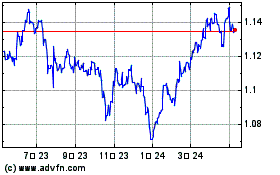Pounds Falls On Weak U.K. Employment Data
2024年11月12日 - 1:42PM
RTTF2
The British pound weakened against other major currencies in the
European session on Tuesday, after the U.K. unemployment rate rose
more than expected in the third quarter and wage growth softened,
adding pressure on the Bank of England to cut interest rates
further.
Data from the Office for National Statistics showed that the
unemployment rate rose to 4.3 percent in the September quarter from
4.0 percent in three months to August period. The rate was seen at
4.1 percent.
Excluding bonus, average earnings gained 4.8 percent in three
months to September, the weakest since mid-2022. This follows an
increase of 4.9 percent in the preceding period. Wage growth was
forecast to ease to 4.7 percent.
Average earnings including bonus grew 4.3 percent annually. The
ONS said the annual increase was affected by the civil service
one-off payments made in July and August 2023. Economists had
expected an increase of 3.9 percent.
Job vacancies decreased for the 28th consecutive period in three
months to October, the ONS said. The number of vacancies declined
35,000 on the quarter to 831,000.
Data showed that payrolled employees decreased 5,000 in October
from a month ago but increased 95,000 from the previous year, to
30.4 million.
Claimant count rose by 26,700 in October after rising 10,100 in
September. However, this was smaller than economists' forecast of
30,500.
There were an estimated 48,000 working days lost because of
labor disputes in September.
Last week, the BoE had lowered its interest rate by a
quarter-point to 4.75 percent. Previously, the U.K. central bank
had reduced the policy rate by a quarter-point in August, which was
the first reduction since March 2020.
European stocks traded lower, after reports emerged that U.S.
President-elect Donald Trump will appoint Michael Waltz as his
national security adviser and Marco Rubio as secretary of state,
indicating hardline positions on China, Iran and Venezuela.
Meanwhile, according to data provider DDHQ, Trump's Republican
Party had won a majority in the U.S. House of Representatives,
signaling a majority for Republicans in both chambers of
Congress.
It is feared that Trump's aggressive tariff hikes could fuel
inflation eventually and stop the Fed from cutting rates. Tariffs
also carry the risk of retaliation from major trading partners.
On the economic front, the focus remains on U.S. consumer price
inflation data on Wednesday, and a slew of speeches by Federal
Reserve officials this week, including Fed Chair Jerome Powell on
Thursday.
In the European trading now, the pound fell to a 3-month low of
1.2792 against the U.S. dollar, from an early high of 1.2874. On
the downside, 1.26 is seen as the next support level for the
pound.
Against the Swiss franc and the yen, the pound slid to 4-day
lows of 1.1280 and 196.89 from early highs of 1.1339 and 198.06,
respectively. If the pound extends its downtrend, it is likely to
find support around 1.11 against the franc and 194.00 against the
yen.
The pound edged down to 0.8303 against the euro, from an early
high of 0.8278. The next possible downside target for the pound is
seen around the 0.84 region.
Looking ahead, Germany ZEW economic sentiment for November is
set to be released in the European session.
In the New York session, U.S. NFIB business optimism index for
October, Canada building permits for September, U.S. Redbook
report, U.S. consumer inflation expectations for October are slated
for release.
Sterling vs CHF (FX:GBPCHF)
FXチャート
から 10 2024 まで 11 2024

Sterling vs CHF (FX:GBPCHF)
FXチャート
から 11 2023 まで 11 2024
